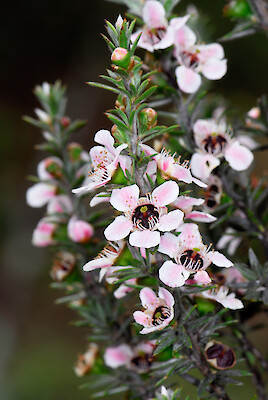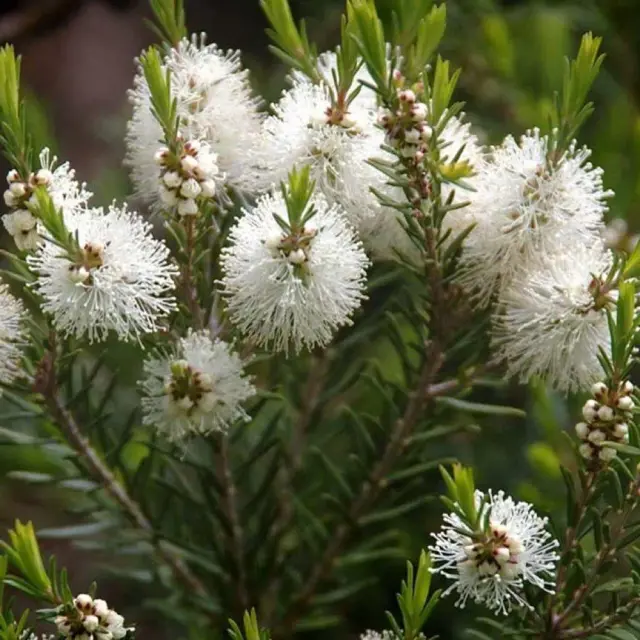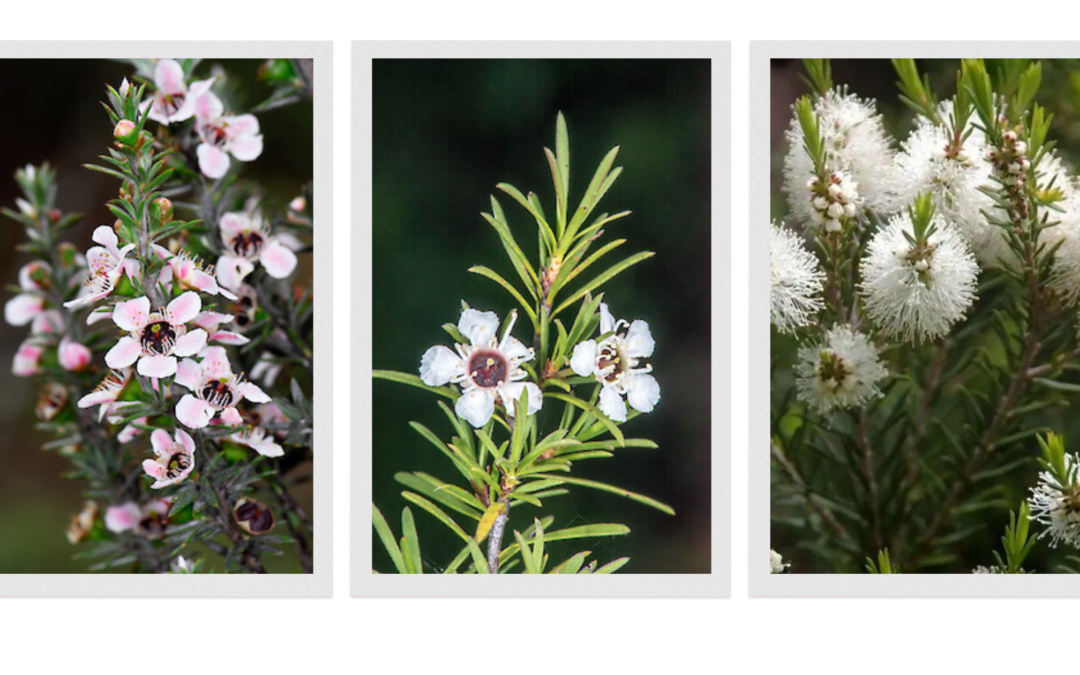In the world of fragrant remedies, essential oils have gained widespread popularity, with mānuka, kānuka, and tea tree oils leading the pack.
While they share a botanical lineage, distinguishing between these oils can confuse many.
Mānuka, Kānuka, and Tea Tree: What Sets Them Apart?
These three trees belong to the same plant family, Myrtaceae, yet they exhibit distinct genetic differences despite sharing several common traits.
The Origin

Image Credits: https://www.nzpcn.org.nz/flora/species/leptospermum-scoparium-var-incanum/
Mānuka (Leptospermum scoparium) originates from New Zealand. It is a robust shrubby tree, reaching heights of up to 10 metres, and thrives in various environmental conditions. Particularly abundant along the East Coast of Aotearoa, the mānuka yields potent oil rich in compounds such as flavonoids, Leptospermone, trans-Calamenene, Cadina-1,4-diene, delta- Cadinene, and Isoleptospermone.

Image Credits: https://www.nzpcn.org.nz/flora/species/kunzea-ericoides/
Indigenous to New Zealand, kānuka (Leptospermum ericoides) can grow up to 30 metres tall and is distributed throughout the region. It is characterised by hanging branches and clusters of small white or pale pink blossoms, resembling mānuka trees. Historically, mānuka and kānuka have been utilised by the Māori people for their medicinal properties.

Image Credits: https://myplantin.com/plant/2660
Native to Australia, the tea tree (Melaleuca alternifolia) encompasses nearly 300 varieties, ranging from 16 to 35 metres tall, with flowers growing in bushy heads on branch ends. Extracted by distilling its leaves and flowers, Tea Tree oil shares similarities with Kānuka oil in composition, albeit with milder effects.
The Scent
Mānuka oil offers a distinctive fragrance characterised by its earthy, refreshing, and pleasing notes. Those with sensitive senses might perceive this fragrance as a mild and comforting sensory journey. Adding to its earthy essence, mānuka oil contains nuanced, sweet undertones and traces of wood, spice, and honey.
Kānuka oil is related to tea tree, eucalyptus, and clove bud and has a sweet, fresh, herbaceous aroma with an earthy not. It has a much sweeter scent than mānuka oil.
Meanwhile, tea tree oil owes its distinctive herbaceous and astringent scent to monoterpenes. The aroma is medicinal, but many become fond of the aroma after becoming accustomed to it.
The Extraction Process

Mānuka essential oil is carefully made using a method called steam distillation. In this process, steam goes over the leaves and small branches of the mānuka plant for a long time, usually about five hours. Known for its multifaceted properties, including anti-fungal, antibacterial, antiviral, anti-inflammatory, antimicrobial, and antiseptic characteristics, mānuka oil has been employed in traditional Māori medicine for treating various ailments.
Like mānuka, kānuka oil is also extracted through distillation from its leaves and flowers. It is rich in alpha-pinene, rendering it an effective anti-inflammatory agent. Comprising key components such as alpha-Pinene, Viridiflorol, Limonene, and 1,8-Cineol, kānuka oil possesses potent anti-fungal, antibacterial, antiviral, and antiseptic properties, serving as an excellent pain reliever and massage oil for sore joints and muscles, as well as aiding in congestion relief and insect repellence. Internally, it functions as a probiotic when incorporated into dietary items like smoothies and salad dressings.
Tea tree oil is made by using steam to extract oil from the leaves and ends of branches of the Melaleuca. alternifolia plant. After condensing, the clear to light yellow oil is separated from the liquid left over. Typically, 1 to 2% of the wet plant material’s weight is collected as oil.
Understanding the Benefits of Mānuka, Kānuka, and Tea Tree
This comparison explores each oil’s unique qualities and therapeutic properties, showing their effectiveness in addressing various health concerns.
Mānuka Oil
- Effective against fungal infections, with potent antibacterial characteristics.
- Contains compounds with potential antiviral properties.
- Demonstrates anti-inflammatory effects, aiding in reducing inflammation.
- Exhibits antimicrobial capabilities against various microorganisms.
- Possesses antiseptic qualities, promoting wound healing.
- Offers a warm, gently floral scent, ideal for aromatherapy.
- Considered safer for sensitive skin compared to Tea Tree oil.
- Provides relief from various ailments including pain.
- Widely used in skin care, wound healing, and other therapeutic applications.
Kānuka Oil
- Potent against fungal issues and effective in addressing bacterial infections.
- Shows evidence of possessing antiviral properties, potentially beneficial against viruses.
- Demonstrates anti-inflammatory properties, alleviating discomfort.
- Exhibits antimicrobial properties, aiding in inhibiting microorganisms’ growth.
- Demonstrates antiseptic properties, contributing to skin health.
- Characterised by a sweet, resinous aroma with hints of Eucalyptus.
- Particularly effective for sore joints and muscles, providing relief.
- May act as a probiotic when consumed internally, promoting gut health.
- Utilised in skincare formulations and massage oils for therapeutic benefits.
Tea Tree Oil
- Contains strong anti-fungal properties that are effective against various fungal infections.
- Acknowledged for its antibacterial activity against bacterial infections.
- Contains compounds with antiviral properties, commonly used in viral treatments.
- Recognised for its anti-inflammatory effects, contributing to therapeutic applications.
- Exhibits antimicrobial activity, effective against microorganisms.
- Possesses antiseptic qualities, commonly used for wound care.
- Exhibits a herbaceous and astringent scent profile, popular in personal care products.
- Information regarding its suitability
Mānuka Oil vs Kānuka Oil vs Tea Tree: Chemical Compositions
The table below shows the comparison of major essential oil compounds in mānuka, kānuka, and tea tree:
| Compound | Mānuka | Kanuka | Tea Tree (Aus) |
| α-pinene | 1.3 | 55.5 | 3.5 |
| ρ-cymene | 0.2 | 3.4 | 4.3 |
| sabinene | 0 | 0 | 1.8 |
| α-terpinene | 0 | 0 | 9 |
| 1,8-cineole | 0.2 | 3.9 | 7.5 |
| limonene | 0.1 | 3.9 | 1.0 |
| γ-terpinene | 0.2 | 2.5 | 19.0 |
| terpinolene | 0 | 0 | 3.3 |
| terpinen-4-ol | 0 | 0.2 | 39.0 |
| α-terpineol | 0.1 | 0.9 | 4.8 |
| α-cubebene | 4.0 | 0.2 | |
| α-copaene + γ-yaylangene | 5.9 | 0.6 | |
| α-gurjunene | 1.0 | 0.4 | |
| β-caryophyllene | 2.6 | 0.5 | |
| aromadendrene | 2.1 | 0.5 | 1.5 |
| cadina-3,5-diene | 4.9 | 0.5 | |
| δ-amorphene | 3.8 | 0.5 | |
| β-selinene | 3.7 | 0.3 | |
| α-selinene (+ viridiflorene) | 4.4 | 2.4 | 1.5 |
| calamenene | 14.4 | 3.0 | |
| δ-cadinene | 6.0 | 1.0 | 1.5 |
| flavesone β-triketone | 4.9 | 0 | |
| cadina-1,4-diene | 5.9 | 1.3 | |
| β-nerolidol | 0.2 | 1.8 | |
| spathulenol | 0.5 | 1.3 | |
| viridiflorol | 0.5 | 7.2 | 0.5 |
| ledol | 0.2 | 1.9 | |
| isoleptospermone β-triketone | 4.6 | 0 | |
| leptospermone β-triketone | 15.5 | 0 | |
| Total β-triketones (MßTK) | 25 | 0 | 0 |
What is the Right Essential Oil to Choose?
When considering which essential oil to use among mānuka, kānuka, and tea tree, it’s essential to understand that each oil offers distinct properties and benefits, making them suitable for different purposes.
Safety and Precautions
While these oils offer numerous advantages, they also come with possible side effects. For instance, undiluted mānuka oil might cause skin irritation in some people. Likewise, tea tree oil can trigger skin reactions if not properly diluted. Therefore, it’s crucial to perform a patch test and follow the recommended dilution instructions when using these oils.

